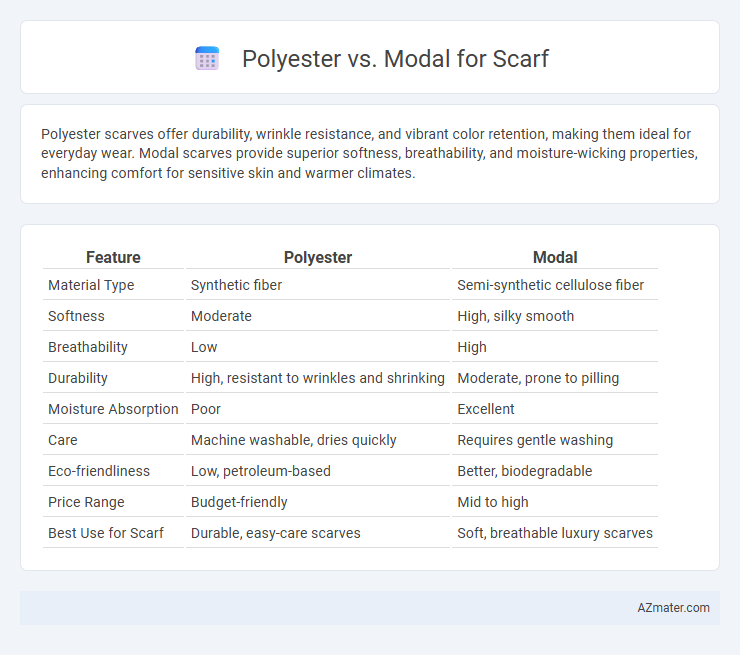Polyester scarves offer durability, wrinkle resistance, and vibrant color retention, making them ideal for everyday wear. Modal scarves provide superior softness, breathability, and moisture-wicking properties, enhancing comfort for sensitive skin and warmer climates.
Table of Comparison
| Feature | Polyester | Modal |
|---|---|---|
| Material Type | Synthetic fiber | Semi-synthetic cellulose fiber |
| Softness | Moderate | High, silky smooth |
| Breathability | Low | High |
| Durability | High, resistant to wrinkles and shrinking | Moderate, prone to pilling |
| Moisture Absorption | Poor | Excellent |
| Care | Machine washable, dries quickly | Requires gentle washing |
| Eco-friendliness | Low, petroleum-based | Better, biodegradable |
| Price Range | Budget-friendly | Mid to high |
| Best Use for Scarf | Durable, easy-care scarves | Soft, breathable luxury scarves |
Introduction to Polyester and Modal Scarves
Polyester scarves are crafted from durable synthetic fibers known for their wrinkle resistance, vibrant color retention, and affordability, making them popular choices for everyday wear. Modal scarves, made from semi-synthetic fibers derived from beech tree pulp, offer exceptional softness, breathability, and moisture-wicking properties, appealing to those seeking comfort and eco-friendly options. Both materials vary significantly in texture, care requirements, and environmental impact, influencing consumer preferences in scarf selection.
Fiber Origins: What Are Polyester and Modal?
Polyester is a synthetic fiber derived from petrochemical sources, renowned for its durability and resistance to wrinkles and shrinking. Modal is a semi-synthetic fiber made from beech tree cellulose, celebrated for its softness, breathability, and eco-friendly production process. Choosing between polyester and modal for scarves hinges on preferences for sustainability, texture, and moisture-wicking properties.
Texture and Feel: Comparing Comfort Levels
Modal scarves offer a soft, silky texture that feels smooth and breathable against the skin, enhancing comfort during prolonged wear. Polyester scarves tend to have a slightly stiffer and less natural feel, which may cause less breathability but provide greater durability and wrinkle resistance. Choosing between modal and polyester depends on the desired balance of luxurious softness versus easy maintenance in scarf comfort.
Durability and Longevity of Each Fabric
Polyester scarves offer exceptional durability, resisting stretching, shrinking, and wrinkling while maintaining vibrant colors over time. Modal, a type of rayon made from beech tree pulp, provides a softer feel but is generally less durable than polyester, tending to pill or degrade faster with frequent washing. For longevity, polyester scarves outperform modal by retaining shape and color through prolonged use and multiple cleanings.
Breathability and Moisture Management
Modal scarves excel in breathability and moisture management due to their natural cellulose fibers, allowing better air circulation and efficient moisture absorption. Polyester scarves tend to trap heat and moisture, making them less breathable and prone to retain sweat, which can lead to discomfort. Choosing modal enhances comfort during prolonged wear by maintaining softness and dryness, ideal for sensitive skin and humid conditions.
Eco-Friendliness and Sustainability Factors
Modal scarves offer superior eco-friendliness compared to polyester, as modal fibers are derived from sustainably harvested beechwood trees and produced through a closed-loop process minimizing water and chemical use. Polyester, a synthetic fabric made from petroleum-based products, contributes significantly to environmental pollution due to its non-biodegradable nature and microplastic shedding during washing. Choosing modal scarves supports sustainable forestry practices and reduces plastic waste, making them a more environmentally responsible option for eco-conscious consumers.
Color Retention and Print Quality
Polyester scarves excel in color retention due to their synthetic fibers that resist fading even after multiple washes, maintaining vibrant hues over time. Modal scarves offer a softer texture but tend to absorb dyes differently, resulting in prints with a more muted and subtle appearance. When prioritizing long-lasting, vivid print quality and bright colors, polyester is the preferred choice for scarves.
Maintenance: Washing and Care Instructions
Polyester scarves require low maintenance, offering machine washability with cold water and quick drying without risk of shrinking or wrinkles. Modal scarves demand gentler care, typically hand washing or using a delicate cycle with cold water, avoiding high heat to preserve softness and prevent fabric damage. Proper maintenance extends the lifespan of both materials while preserving their texture and appearance.
Price Comparison: Which is More Cost-Effective?
Polyester scarves are generally more cost-effective than modal scarves, with polyester averaging $5-$15 per piece compared to modal's $15-$40 range. The lower production costs and synthetic nature of polyester contribute to its affordability, making it a popular choice for budget-conscious consumers. Modal, derived from beech tree pulp, tends to be pricier due to its natural origins and softer, breathable qualities that justify higher price points.
Best Uses: Which Fabric Suits Your Style?
Polyester scarves are ideal for those seeking durability, vibrant color retention, and wrinkle resistance, making them perfect for everyday casual wear and travel. Modal scarves offer a silky, breathable texture with excellent moisture-wicking properties, suited for those prioritizing comfort and luxury in formal or semi-formal settings. Choosing between polyester and modal depends on your style preference and intended use, balancing practicality with softness and elegance.

Infographic: Polyester vs Modal for Scarf
 azmater.com
azmater.com